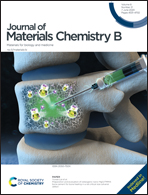Controllable hydrogen bonded self-association for the formation of multifunctional antimicrobial materials†
Abstract
SSAs are a class of supramolecular self-associating amphiphilic salt, the anionic component of which contains a covalently bound hydrogen bond donor–acceptor motif. This results in a monomeric unit which can adopt multiple hydrogen bonding modes simultaneously. Previous investigations have shown examples of SSAs to act as antimicrobial agents against clinically relevant methicillin-resistant Staphylococcus aureus (MRSA). Herein, we report an intrinsically fluorescent SSA which can self-associate producing dimers, spherical aggregates and hydrogels dependent on solvent environment, while retaining antimicrobial activity against both model Gram-positive (MRSA) and Gram-negative (Escherichia coli) bacteria. Finally, we demonstrate the SSA supramolecular hydrogel to tolerate the inclusion of the antibiotic ampicillin, leading to the enhanced inhibition of growth with both model bacteria, and derive initial molecular structure–physicochemical property–antimicrobial activity relationships.



 Please wait while we load your content...
Please wait while we load your content...